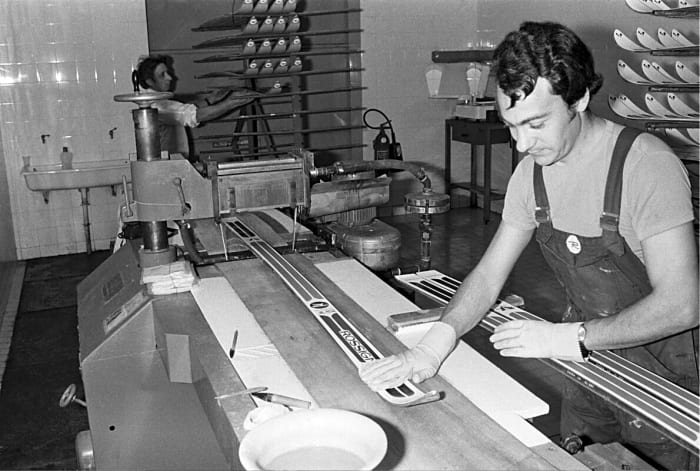
These days, it seems like ski technology has hit a bit of a ceiling despite the fact that brands seem to be able to put out all kinds of new, weird technology each year. With so much already out there, it's hard to say what the next big breakthrough in ski construction or shaping will be or what trend will suddenly take hold of the industry.
But before the days when high-quality skis for every type of snow condition were available, brands were still tasked with creating skis that were light, nimble, could float in pow or hold an edge on ice. As with many sports, the progression of ski equipment had a huge effect on the progression of the sport itself. Here are a few of the skis that changed how skis are made today, whether it be by the material used, the shape or what they allowed those skiing them to do.
This piece is part of POWDER's Summer of Ski Nostalgia content series. Stay tuned in daily for more nostalgic articles, and keep an eye out for the upcoming Summer of Ski Nostalgia badge to identify future content.
You can also view all of POWDER's summer nostalgia content here.
Want to keep up with the best stories and photos in skiing? Subscribe to the new Powder To The People newsletter for weekly updates.

1. Head Standard (1947)
Aeronautical engineer Howard Head dreamed up the first commercially viable aluminum laminate skis after a day of trying to learn the sport on a pair of wooden planks. The first pair of Head Standards were built with Head's earnings from a poker game. With a plywood core between aluminum outer pieces, steel edges, a plastic base, sidewalls, and a topsheet, the Standards were effectively the first-ever modern downhill ski.
Its length and flexibility made the ski easy to turn while still holding an edge, an essential facet of the sport we know today. Head Skis launched not long after the first pair was built, making metal laminate skis the new standard in ski construction. The Standard itself was so successful that about half the downhill skis in the U.S. in the 1960s were Head skis.

2. Rossignol Strato (1964)
Rossignol had already put themselves on the map with all wooden skis, but in the early '60s, the brand came up with a construction that would change construction forever. The Rossignol Strato was perfected in 1964 and was the first ski to combine fiberglass laminates with a wooden core.
The ski was meant to "liberate" the skier by making more precise handling and creating a larger turn radius with the composite core structure. The Strato was one of the most popular skis of all time and was marketed by Rossignol until 1975.
3. Blizzard Total (1971)
The early days of skis didn't see much in the way of topsheet graphics, but in the early 70s, Blizzard sought to change that. The brand is credited with being the first to figure out how to use the silkscreen printmaking process to put graphics onto skis, starting with the Blizzard Total, which was released in 1971.
Today, the Blizzard factory in Mittersill, Austria, still uses a silkscreening process to print graphics onto their skis and employs entirely women in the printing department of the factory. Around the same time, Blizzard would also release the first version of their Firebird race ski, which was one of the first skis to use a combination wood/foam core.
4. Atomic Powder Magic (1988)
In search of a ski that could handle deep powder, Atomic tasked Rupert Huber, one of their engineers at the time, with creating one. Huber supposedly sawed a snowboard in half and slapped some ski bindings on it.
His Frankenstein snowboard creation would soon become the Atomic Powder Magic, which was the first true powder ski on the market at 115mm underfoot. Much wider and shorter than many of the other available skis at the time, the Powder Magic's were the predecessor for the modern day powder ski, which aren't all that different.
5. Elan SCX (1991)
Elan Skis was created during WWII by Slovenian ski jumper Rudi Finzgar, who made skis as a piece of military equipment. When the war ended, the company lived on and continued to make skis, officially becoming Elan in 1952. Eventually, Swedish World Cup racing legend Ingemar Stenmark joined forces with Elan, placing them on the map as a reputable race ski brand.
In the '90s, two of the company's Slovenian engineers designed a giant slalom ski that was 63mm underfoot, 110mm at the tip, and 105mm in the tail, creating the first ever ski with sidecut. The tell-tale hourglass shape belongs to the Elan SCX, which revolutionized ski shaping.
6. Salomon TenEighty (1997)
Designed with the help of "the Godfather of Freeskiing," Mike Douglas, the Salomon TenEightys were the first widely available twin-tip ski on the market. Douglas approached his long-time ski sponsor wanting something with a tail that would allow him to ski and land backwards. The TenEighty revolutionized what we know now as freestyle and powder skis and effectively helped to launch the freeskiing movement.
7. 4FRNT MSP (2002)
Born from the founder of 4FRNT skis, the MSP, or Matt Sterbenz Pro, was the kind of ski that skiers like a young Sterbenz craved at the time. The MSP looked to fill a gap in freeride skis for skiers focused on freestyle skiing. Some large ski brands were already making twin-tipped freeride skis such as the TenEighty, but many skiers found the construction too heavy and too similar to older race skis.
The original MSP was a stiff ski with a mid-90s waist width, a full-length maple core, P-Tex sidewalls, and came in a 160, 170, or 180cm length. After a brief hiatus, the MSP made a return to the 4FRNT lineup in their 2016/27 line and has remained a staple ski with options in several widths.
8. Volant Spatula (2001)
The Volant Spatula was basically the first fully rockered or reverse camber ski on the market. Designed by the prolific Shane McConkey and Peter Turner, the Spatula was made to make skiing deep powder easier. Inspired by the shape of water skis with minimal sidecut, no camber, and tip and tail rocker, the Spatula encouraged skiers to float and slide down snow instead of carving, while keeping their tips above deep snow.
The Spatulas were a whopping 125mm underfoot, long, and heavy, making them a true powder-only ski. The Spatula's reign was short lived, and Volant only manufactured them until 2003, but inspired a number of other skis, including the K2 Pontoon.
More must-reads:
- Three NHL teams that have missed the mark so far this offseason
- Joey Chestnut once again king of Nathan's Hot Dog Eating Contest
- The '2025 MLB All-Star Starters' quiz
Breaking News
Trending News
Customize Your Newsletter
 +
+
Get the latest news and rumors, customized to your favorite sports and teams. Emailed daily. Always free!








